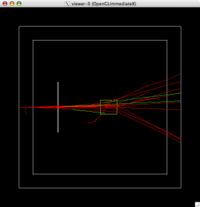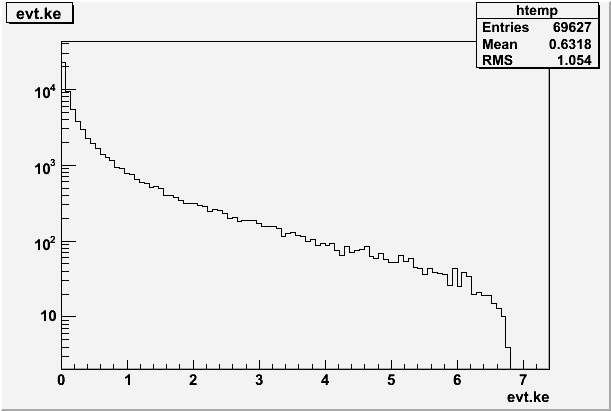Difference between revisions of "HRRL Simulations"
(→Run 1) |
(→Run 1) |
||
| Line 57: | Line 57: | ||
The total photon radiation hitting the upper half of the experimental cell is predicted to be 1.4 krad/hr. To determine the dose on a radiation detector you just need to scale by the solid angle. | The total photon radiation hitting the upper half of the experimental cell is predicted to be 1.4 krad/hr. To determine the dose on a radiation detector you just need to scale by the solid angle. | ||
| + | |||
| + | |||
| + | ==Run 2: Floor Penetration== | ||
| + | |||
| + | A 6 inch concrete floor is assumed to exist on the top of the experimental cell which will block radiation from penetrating to the offices above the cell. | ||
| + | |||
[http://www.iac.isu.edu/mediawiki/index.php/HRRL Go back] | [http://www.iac.isu.edu/mediawiki/index.php/HRRL Go back] | ||
Revision as of 09:53, 15 July 2008
This document describes the simulations performed to estimate the radiological background in the event that a 1 nA electron current from the HRRL enters the experimental cell.
Radiation monitors: Ludlum Model 45-8.
Low energy gamma cutoff = 60 keV
Tungsten SImulation
I created a world volume filled with Air to represent the experimental cell.
I created a 2mm thick tungsten target that is 30 cm x 30 cm in area.
The image below shows several electrons hitting the tungsten foil, then scattering in air. The red lines are electrons and the green ones are photons.
Run 1
I then ran 1 million events in which an incident 7 MeV electron hit the 2 mm thick Tungsten with the physics processes
if (particleName == "gamma") {
// gamma
pmanager->AddDiscreteProcess(new G4PhotoElectricEffect);
pmanager->AddDiscreteProcess(new G4ComptonScattering);
pmanager->AddDiscreteProcess(new G4GammaConversion);
} else if (particleName == "e-") {
//electron
pmanager->AddProcess(new G4MultipleScattering,-1, 1,1);
pmanager->AddProcess(new G4eIonisation, -1, 2,2);
pmanager->AddProcess(new G4eBremsstrahlung, -1, 3,3);
I only kept event in which had a momentum component towards the ceiling
The energy distribution (in MeV) of the gammas headed towards the roof is shown below. Of the 1 million electrons incident on the 2 mm thick Tungsten target, only 70,000 gammas were headed towards the cieling. This does not mean that they hit it, they could have hit the wall.
If I sum the above distribution I see a total energy of 43,987 MeV going up from the 1 million 7 MeV electrons hitting the 2mm Tungsten target.
1 Rad = = the amount of energy absorbed per 100 kg of material
To calculate the worst possible case lets assume all of the radiation is absorbed by a person (there is no concrete ceiling).
Converting the energy from MeV to Joules
In terms of the energy per beam current charge we would have
I we ran the HRRL for 1 hour at the maximum beam current of 80 mA per 100 ns pulse and 1 kHz rep rate then the dose to the ceiling would be
The total photon radiation hitting the upper half of the experimental cell is predicted to be 1.4 krad/hr. To determine the dose on a radiation detector you just need to scale by the solid angle.
Run 2: Floor Penetration
A 6 inch concrete floor is assumed to exist on the top of the experimental cell which will block radiation from penetrating to the offices above the cell.

